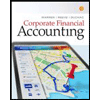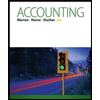
Concept explainers
(a)
Common stock: These are the ordinary shares that a corporation issues to the investors in order to raise funds. In return, the investor receives a share of profit from the profits earned by the corporation.
Par value: It refers to the value of a stock that is stated by the corporation’s charter. It is also known as face value of a stock.
No-par common stock: The common stock that is issued at its fair market value is known as no-par common stock. Common stocks are the ordinary shares that a corporation issues to the investors in order to raise funds. In return, the investor receives a share of profit from the profits earned by the corporation.
To Journalize: the issuance of common stock transaction at a par value of $5 per share for Corporation M on January 10.
To Journalize: the issuance of common stock transaction at $7 per share for Corporation M on July 1.
(b)
To Journalize: the issuance of common stock transaction at no-par value with a stated value of $1 for Corporation M on January 10.
To Journalize: the issuance of common stock transaction at no-par value with a stated value of $1 for Corporation M on July 1.
Trending nowThis is a popular solution!

Chapter 11 Solutions
FINANCIAL ACCOUNTING: TOOLS FOR BUSINES
- Nullarrow_forwardThirst Quencher produced 20,000 cases of powdered drink mix and sold 17,000 cases in April. The sales price was $22 per case, variable costs were $14 per case ($10 manufacturing and $4 selling and administrative), and total fixed costs were $55,000 ($40,000 manufacturing overhead and $15,000 selling and administrative). The company had no beginning Finished Goods Inventory. Requirements1. Prepare the April income statement using absorption costing.Known - OI $87,000 2. Determine the product cost per unit and the total cost of the 3,000 cases in Finished Goods Inventory as of April 30. 3. Is the April 30 balance in Finished Goods Inventory higher or lower than variable costing? Explain why.arrow_forwardDon't use ai given answer financial accountingarrow_forward
- I am searching for the accurate solution to this financial accounting problem with the right approach.arrow_forwardPlease explain the correct approach for solving this general accounting question.arrow_forwardn 2022, Alexis transferred $442,000 to a trust with directions to pay income to her spouse, William, for his life. After William's death, the corpus of the trust will pass to William's son. If the life estate is valued at $72,250, what is the total amount of the taxable gifts?arrow_forward
- Could you help me solve this financial accounting question using appropriate calculation techniques?arrow_forwardCan you help me solve this general accounting question using valid accounting techniques?arrow_forwardPlease explain this financial accounting problem by applying valid financial principles.arrow_forward
 Cornerstones of Financial AccountingAccountingISBN:9781337690881Author:Jay Rich, Jeff JonesPublisher:Cengage Learning
Cornerstones of Financial AccountingAccountingISBN:9781337690881Author:Jay Rich, Jeff JonesPublisher:Cengage Learning Corporate Financial AccountingAccountingISBN:9781305653535Author:Carl Warren, James M. Reeve, Jonathan DuchacPublisher:Cengage Learning
Corporate Financial AccountingAccountingISBN:9781305653535Author:Carl Warren, James M. Reeve, Jonathan DuchacPublisher:Cengage Learning Accounting (Text Only)AccountingISBN:9781285743615Author:Carl Warren, James M. Reeve, Jonathan DuchacPublisher:Cengage Learning
Accounting (Text Only)AccountingISBN:9781285743615Author:Carl Warren, James M. Reeve, Jonathan DuchacPublisher:Cengage Learning Financial AccountingAccountingISBN:9781305088436Author:Carl Warren, Jim Reeve, Jonathan DuchacPublisher:Cengage LearningPrinciples of Accounting Volume 1AccountingISBN:9781947172685Author:OpenStaxPublisher:OpenStax College
Financial AccountingAccountingISBN:9781305088436Author:Carl Warren, Jim Reeve, Jonathan DuchacPublisher:Cengage LearningPrinciples of Accounting Volume 1AccountingISBN:9781947172685Author:OpenStaxPublisher:OpenStax College




